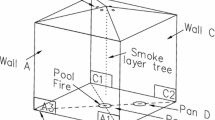Abstract
In the description of the characteristic volume of fire behavior, fire intensityI, rate of spreadR, and flame lengthL, etc. all have their scientific definitions, while the bound between the firclinc and the residual region of a fire scene is not yet scientifically defined. This paper tries to find out theoretically the basis for dividing the bound, to give the fireline thicknessD a scientific definition, and to propose a method of quantitative calculation. According to the generality of fuels, the time-dependent curves of fuels combustion rate are utilized to work out a formula by, experience. On the basis of defining scientifically the fireline thickness, the Byram’s formula is corrected, and a new one for calculating the fire intensity of surface fire, i. e.I = 0.788HWr, is presented. In this formula,H is the fuel low heat of combustion, the calculating method of the thermal current intensityJ is given, andJ max = 1.25HWR/D, the calculating formula of flame length is revised, andL = 0.077I 0.46. In the spreading process of the forest fire, when the time needed for getting over a fireline thickness isT, it is called residence time. It is given out in this paper the method for estimating and determining the rate of spreadr and the residence timeT in the combustion chamber. And on this basis the characteristic volume (W, I, R, D, T, L andJ max, etc.) of surface fire behavior can be evaluated.
Similar content being viewed by others
Reference
Byram, G. M. 1959.Combustion of forest fuels.In Forest fire control and use. Edited by K.P. Daves. Mc Graw Hill, New York. pp. 61–89.
Dept. of Mathematics, Sichuam Univ, 1987,Higher Mthemalics No. 201, Vol, 4. People’s Education Publishing House. (in Chinese)
Wang Zi cheng, 1989,Thermodymamics. statistical physics. No. 171. Higher education pulilishing House. (in Chinese).
A. Tewarson, 1972:some Observations on Experimental Fires in Enclosures, Combustion and Flame 19. 101–111.
Liang kun miao, 1979.Mathematical and physical method, No. 521. The People’s Education Publishing House, (in Chinese).
Wang Tsen fei, 1983.Method of Calculating the Initial Spread Rate of Mountain Fire, Study on Mountainous Region Vol, 2, No. 51
Broum, A. A., 1973Forest fire control and use.Second edition, Mc Graw Hill, New York.
Alexande, M. E. 1982.Calculating and interpreting forest fire intensities.Can. J. Bot. 60 (4), 349–357.
Zheng Huan neng, Ju En de, et al: 1988.Forest Fire Management, No. 4. Publishing House of Northeast Forestry Univer sity. (in Chinese).
Author information
Authors and Affiliations
Rights and permissions
About this article
Cite this article
Ende, J., Dawo, C. Quantitative calculation of characteristic volume of surface fire behavior. J. Northeast For. Univ. 3, 59–69 (1992). https://doi.org/10.1007/BF02843039
Received:
Issue Date:
DOI: https://doi.org/10.1007/BF02843039




